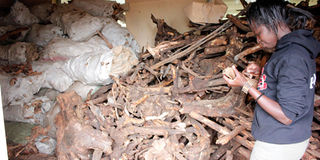Inside the race to save sandalwood timber

Impounded sandalwood in a storeroom in Baringo County in this past photo. Sandalwood cultivation could ease pressure on natural populations while providing income to farmers. PHOTO | FILE | NATION MEDIA GROUP
What you need to know:
- As the tree rapidly vanishes in Kenya, Frouza is among eco-warriors waging war on two fronts to stop its extinction.
- A growing consensus is that the war on this front is a losing one despite a government ban on trade in its products.
- These are plants that were noticed growing next to sandalwood in what the scientists now know is a symbiotic relationship.
- The target is to propagate up to 10,000 sandalwood trees a year. These farms will, hopefully, provide Kenya’s seed capital.
Frouza Maingi sits behind a large table in her office at the Kenya Forestry Research Institute (Kefri) laboratory in Kitui.
On top of the table are containers filled with cowpea-sized orange and brown seeds of the endangered Osyris lanceolata (sandalwood) tree. On one side of the wall, stacked on shelves, are box files containing information on the seeds’ origin.
Sandalwood is native to semi-arid lands like Kitui but scientists are having to go farther away in search of seeds.
As the tree rapidly vanishes in Kenya, Frouza is among eco-warriors waging war on two fronts to stop its extinction.
First is the security front, which targets illegal loggers harvesting the tree whose products – roots, bark, trunk, leaves and flowers – are coveted by the global pharmaceutical industry.
A growing consensus is that the war on this front is a losing one despite a government ban on trade in its products.
“The smugglers are so organised that at times the drivers don’t know the identities of those they are working with. So even if they are arrested, the trail ends with them. Every lead from them turns cold,” Baringo Kenya Wildlife Service official Kennedy ole Nashuu says in a newspaper report.
It is on the second front, propagation and domestication of the tree, that Kenya has a better chance of winning. And its heavy lifting is at the Dryland Eco-Region Research Programme (DERP) based in Kitui.
Frouza, a lab technologist, has worked here for more than a decade. Kefri says sandalwood cultivation will ease pressure on natural populations while providing income to farmers.
Progress has been slow but there is a single-minded determination to succeed. For many years, seedlings withered and died despite the intensive care they received. This sent researchers back into the wild to study the tree in its natural environment.
One study, published in the Journal of Horticulture and Forestry in 2014, focused on the tree’s indicator plant species.
These are plants that were noticed growing next to sandalwood in what the scientists now know is a symbiotic relationship.
INTRODUCE HOST PLANTS
Carried out by Mary Gathara, Paul Makenzi, James Kimondo and Gabriel Muturi, the study found that sandalwood clustered together with a number of other species also known as host plants.
But the most common one was Rhus natalensis, a fruit tree in the same family as one called omusangura in Luhya whose twigs are used in dental hygiene.
It is knowledge gained from studies such as this one that gives sandalwood a better shot at survival.
Once the seeds are received from the wild, Frouza places them in a jar filled with water. Good ones likely to germinate will sink, bad ones will float.
She separates and cleans the good ones, removing their orange skin to reveal brown seeds with a hard cover.
The seeds are then sown in greenhouses and transferred to nurseries where they remain for 15 months before they are ready for the field.
Dr Albert Luvanda, the regional director, says the seeds’ hard coat requires scarification and soaking in hot water for germination which may take up to 60 days.
Research has sought to answer questions such as at what point to introduce host plants and whether the same hosts in the nursery will work in the field.
“Some hosts are useful in the nursery but not in the field – and vice versa,” Frouza says. Based on this information, Kefri has prepared demonstration farms with host trees already planted.
The target is to propagate up to 10,000 sandalwood trees a year. These farms will, hopefully, provide Kenya’s seed capital.
The scientists are working with a wide range of hosts. They include several species of Acacia (placenta, seyal and geradi), croton, Terminalia brownii and three shrubs (Indigofera erecta, Dedonaea viscosa and senna spectablis).
Even though progress seems slow, there is encouragement from one success story that DERP has achieved – domestication of Melia Volkensii (mukau).
“We can confidently say that mukau is no longer threatened with extinction in Kenya,’’ says Bernard Kigwa, a Kefri expert on the tree. It is hoped that the same can be said of sandalwood in the near future.
Mr Wanyonyi is Managing Partner at Storylines Kenya, [email protected]


